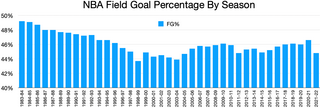Pythagorean expectation is a sports analytics formula devised by Bill James to estimate the percentage of games a baseball team "should" have won based on the number of runs they scored and allowed. Comparing a team's actual and Pythagorean winning percentage can be used to make predictions and evaluate which teams are over-performing and under-performing. The name comes from the formula's resemblance to the Pythagorean theorem.

A box score is a structured summary of the results from a sport competition. The box score lists the game score as well as individual and team achievements in the game.
The player efficiency rating (PER) is John Hollinger's all-in-one basketball rating, which attempts to collect or boil down all of a player's contributions into one number. Using a detailed formula, Hollinger developed a system that rates every player's statistical performance.

Jason Alan Kapono is an American former professional basketball player. He was the first National Basketball Association (NBA) player to lead the league in three-point field goal percentage in two consecutive seasons, and he also won the Three-Point Contest twice. He won an NBA championship with the Miami Heat in 2006.

Field goal percentage in basketball is the ratio of field goals made to field goals attempted. Its abbreviation is FG%. Although three-point field goal percentage is often calculated separately, three-point field goals are included in the general field goal percentage. Instead of using scales of 0 to 100%, the scale .000 to 1.000 is commonly used. A higher field goal percentage denotes higher efficiency. In basketball, a FG% of .500 (50%) or above is considered a good percentage, although this criterion does not apply equally to all positions. Guards usually have lower FG% than forwards and centers. Field goal percentage does not completely tell the skill of a player, but a low field goal percentage can indicate a poor offensive player or a player who takes many difficult shots. In the NBA, center Shaquille O'Neal had a high career FG% because he played near the basket making many high percentage layups and dunks. Guard Allen Iverson often had a low FG% because he took the bulk of his team's shot attempts, even with high difficulty shots.
Statistics in basketball are kept to evaluate a player's or a team's performance.

In basketball, a field goal is a basket scored on any shot or tap other than a free throw, worth two or three points depending on the location of the attempt on the basket. Uncommonly, a field goal can be worth other values such as one point in FIBA 3x3 basketball competitions or four points in the BIG3 basketball league. "Field goal" is the official terminology used by the National Basketball Association (NBA) in their rule book, in their box scores and statistics, and in referees' rulings. The same term is also the official wording used by the National Collegiate Athletic Association (NCAA) and high school basketball.

David L. Budd is a retired American basketball player who played for the National Basketball Association's New York Knicks.
In basketball statistics, rebound rate or rebound percentage is a statistic to gauge how effective a player is at gaining possession of the basketball after a missed field goal or free throw. Rebound rate is an estimate of the percentage of missed shots a player rebounded while he was on the floor. Using raw rebound totals to evaluate rebounding fails to take into account external factors unrelated to a player's ability, such as the number of shots taken in games and the percentage of those shots that are made. Both factors affect the number of missed shots that are available to be rebounded. Rebound rate takes these factors into account.
Offensive proficiency rating or offensive productive efficiency is a statistic used in basketball to measure either a team's offensive performance or an individual player's efficiency at producing points for the offense. It was created by author and statistician Dean Oliver.
In any quantitative science, the terms relative change and relative difference are used to compare two quantities while taking into account the "sizes" of the things being compared, i.e. dividing by a standard or reference or starting value. The comparison is expressed as a ratio and is a unitless number. By multiplying these ratios by 100 they can be expressed as percentages so the terms percentage change, percent(age) difference, or relative percentage difference are also commonly used. The terms "change" and "difference" are used interchangeably.
The 1977–78 NBA season was the team's 17th season in the NBA and their 5th season in the city of Washington, D.C. It would prove to be their most successful season, as they would win their first and only NBA championship as of 2024. In the NBA Finals, they defeated the Seattle SuperSonics in seven games.
The 1974–75 Washington Bullets played in their 14th season, 2nd in the Washington, D.C. area, and first under the Washington Bullets name. The franchise changed their name from the Capital Bullets to the Washington Bullets. The franchise captured its 6th division title in 7 years by posting a franchise best record of 60–22. The Bullets were nearly unbeatable at home posting a record of 36–5 at the Capital Centre. The Bullets won their second Eastern Conference title, but similar to their 1971 appearance, were swept in the NBA Finals in four games, this time by the Golden State Warriors.
The 1973–74 Capital Bullets season was the team's first in Washington, D.C. area, southwest from nearby Baltimore. Prior to the 1973–74 season, the Baltimore Bullets relocated to Landover, Maryland, a suburb east of Washington, and became the Capital Bullets. It was also their only season under the Capital Bullets name.
The 2008–09 Utah Jazz season was the 35th season of the franchise in the National Basketball Association (NBA), and the 30th since the team moved from New Orleans to Salt Lake City for the 1979–80 season.

The IBM Award was an award given out to National Basketball Association players from 1984 to 2002. The award was sponsored and calculated by technology company IBM and was determined by a computer formula, which measured a player's statistical contribution to his team. The player with the best contribution to his team in the league received the award. The first recipient was Magic Johnson of the Los Angeles Lakers, and the final recipient was Tim Duncan of the San Antonio Spurs.

In basketball, true shooting percentage is an advanced statistic that measures a player's efficiency at shooting the ball. It is intended to more accurately calculate a player's shooting than field goal percentage, free throw percentage, and three-point field goal percentage taken individually. Two- and three-point field goals and free throws are all considered in its calculation. It is abbreviated TS%.
Network Science based basketball analytics comprise a various recent attempts to apply the perspective of networks to the analysis of basketball.









